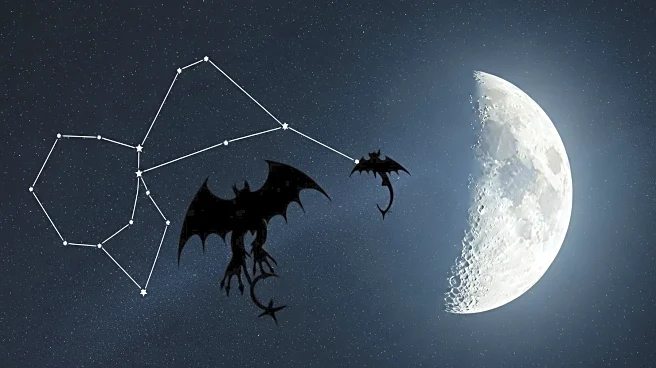What's Happening?
The first quarter moon will be visible in the night sky on August 30, appearing in close proximity to the red supergiant star Antares within the Scorpius constellation. This celestial event will occur as the moon reaches its first quarter phase at 2:25 a.m. on August 31, although it will be below the horizon for viewers in the U.S. The best time to observe the half-lit moon is at sunset on August 30, when it will be positioned less than 20 degrees above the southwestern horizon. The right side of the lunar disk will be illuminated by sunlight, while the left side remains in shadow. The stars of the constellation Libra, historically representing the claws of Scorpius, will be visible to the right of the moon.
Why It's Important?
This celestial event offers a unique opportunity for skywatchers and astronomy enthusiasts to observe the moon in a striking alignment with notable stars. The proximity of the moon to Antares, a prominent star in the Scorpius constellation, enhances the visual spectacle. Such events can inspire interest in astronomy and provide educational opportunities for those interested in learning more about celestial bodies and their movements. Additionally, the upcoming full moon phase on September 7, which will coincide with a total lunar eclipse, promises another significant astronomical event, drawing attention to the wonders of the night sky.
What's Next?
Following the first quarter moon, the next major lunar event will be the full moon on September 7, which will feature a total lunar eclipse. During this eclipse, Earth's shadow will pass over the moon, creating a 'blood moon' effect. This event will be visible in various parts of the world, offering another chance for skywatchers to witness a dramatic transformation of the moon's appearance. Observers are encouraged to prepare for this event by finding suitable viewing locations and using telescopes or binoculars to enhance their experience.
Beyond the Headlines
The alignment of the moon with the Scorpius constellation highlights the intricate dance of celestial bodies and the cultural significance of constellations in astronomy. Scorpius, one of the oldest constellations known to humanity, has been a part of various mythologies and stories across cultures. Observing such alignments can deepen appreciation for the historical and cultural contexts of astronomy, fostering a connection between modern scientific observation and ancient traditions.

